Saturday’s lunchtime kick-off in the Championship saw Gary Monk’s Sheffield Wednesday play out a 0-0 stalemate with Marco Bielsa’s Leeds United at Hillsborough. The point for both sides saw Wednesday drop from third in the Championship table to fifth and Bielsa’s side drop from second to third, with Preston North End moving into the automatic promotion spot.
This tactical analysis will dissect the goalless draw, highlighting areas of the two sides’ tactics which led to the result and use analysis to explain their set-ups further.
Lineups

The home side opted for a 4-4-2, a switch from the 4-1-4-1 system Monk used in Wednesday’s last outing – a 1-0 home victory over Stoke City. Throughout this season Wednesday’s manager has loyally stuck with four-back formations, fluctuating between the 4-4-2 and the 4-1-4-1. Monk has deployed a 4-2-3-1 on one occasion, but not since his first game in charge – a 2-0 away victory over Huddersfield Town. In terms of personnel changes, the 40-year-old made three changes to his starting lineup. Cameron Dawson, Julian Börner and Massimo Luongo made way for Keiren Westwood, Joey Pelupessy and Atdhe Nuhiu.
Leeds’ head coach, Bielsa, opted for a 3-4-3 – which he has done on occasion this season. Predominantly the Argentine’s formation of choice in recent months has been a 4-1-4-1, with some experimentation of three-back formations. The 3-4-3 was last deployed by Leeds the weekend before the goalless draw in a 1-0 home victory over Birmingham City. Despite the change in structure from the midweek 1-1 draw with Preston, Bielsa made no changes in personnel to his starting lineup.
Leeds’ long balls from deep
When in possession, Leeds often looked to move the ball forwards quickly and then control possession in Sheffield Wednesday’s half. To do so, Bielsa tasked his outside defenders in the three-back formation – Luke Ayling and Gaetano Berardi – to play long, lofted balls down the flank. When the option was available Leeds would quickly move the ball forward, and when it was not, the backline would shift the ball from one side to the other to find a gap.
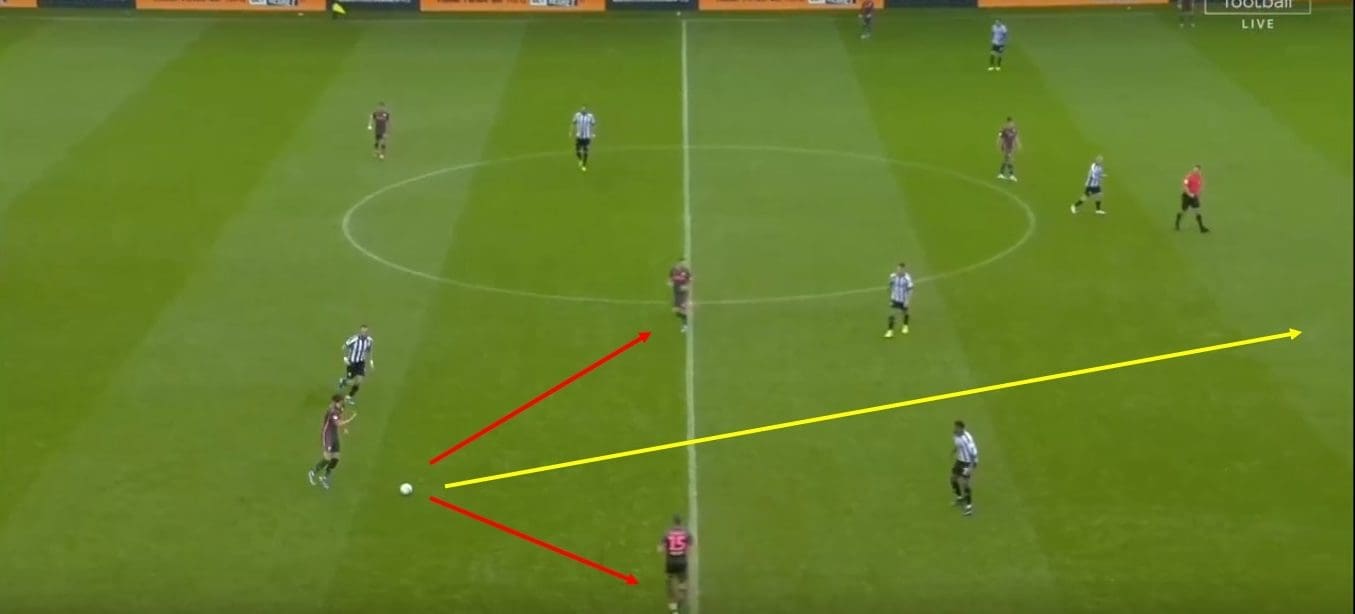
Here, Bielsa’s tactic of moving the ball forward quickly in the wide-area can be seen in action. The ball has been shifted across the defence to make space, and Ayling now has a short passing option to his left and right – as marked by the red arrows. What Ayling does is marked by the yellow arrow, instead of playing a short, simple pass and playing through the thirds – Ayling hits a long, lofted ball between Wednesday’s wide and central midfielders.
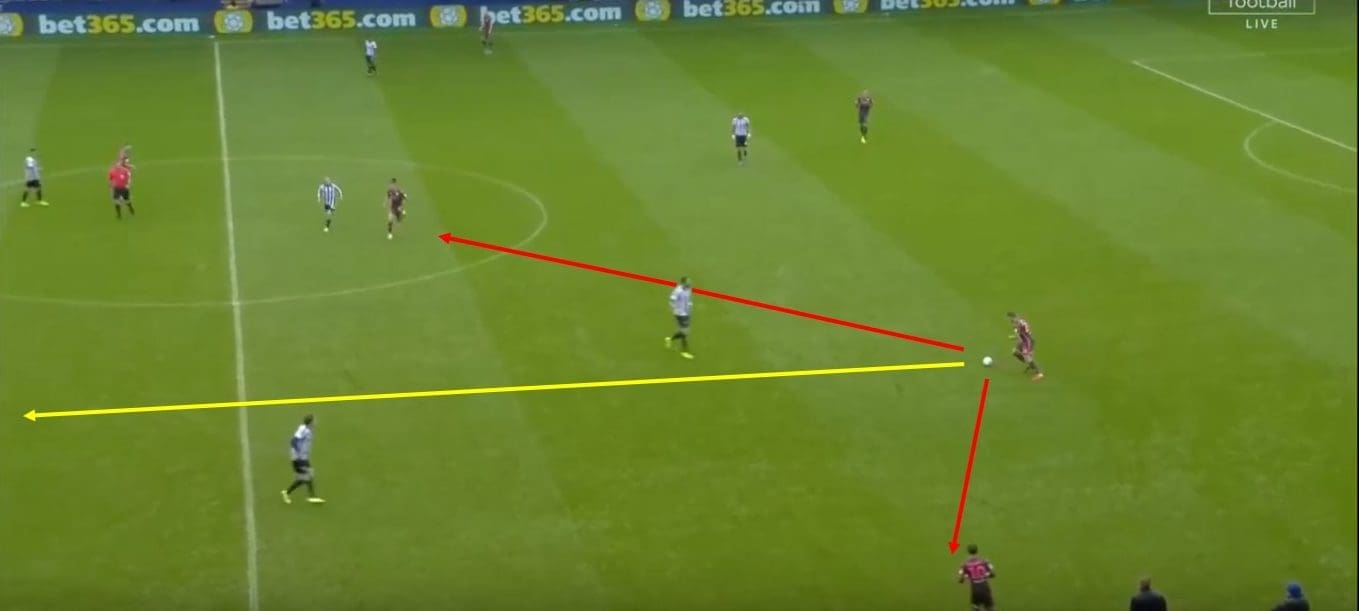
In the above annotation, this tactic can be seen continued into the second half and on the opposite side of Leeds’ backline. The ball has, again, been shifted across the pitch this time to Berardi, however. With passing options to his left and his right – again marked by the red arrows – instead, the Swiss defender opts to play a long ball, punted forwards to move Bielsa’s side up the pitch quickly.
The Owls’ high press
To combat this effort to move the ball up the pitch quickly by Leeds’ backline, Wednesday’s forwards pressed the ball high up the pitch and aggressively. As soon as a Leeds defender or Kiko Casilla would receive possession of the ball, a Wednesday attacker – Nuhiu or Steven Fletcher – would initiate the press. Depending upon the side of the pitch where the Whites had possession of the ball, Nuhiu and Fletcher would be supported by the wide midfielder on that side of the pitch to create a triangle pressing structure.
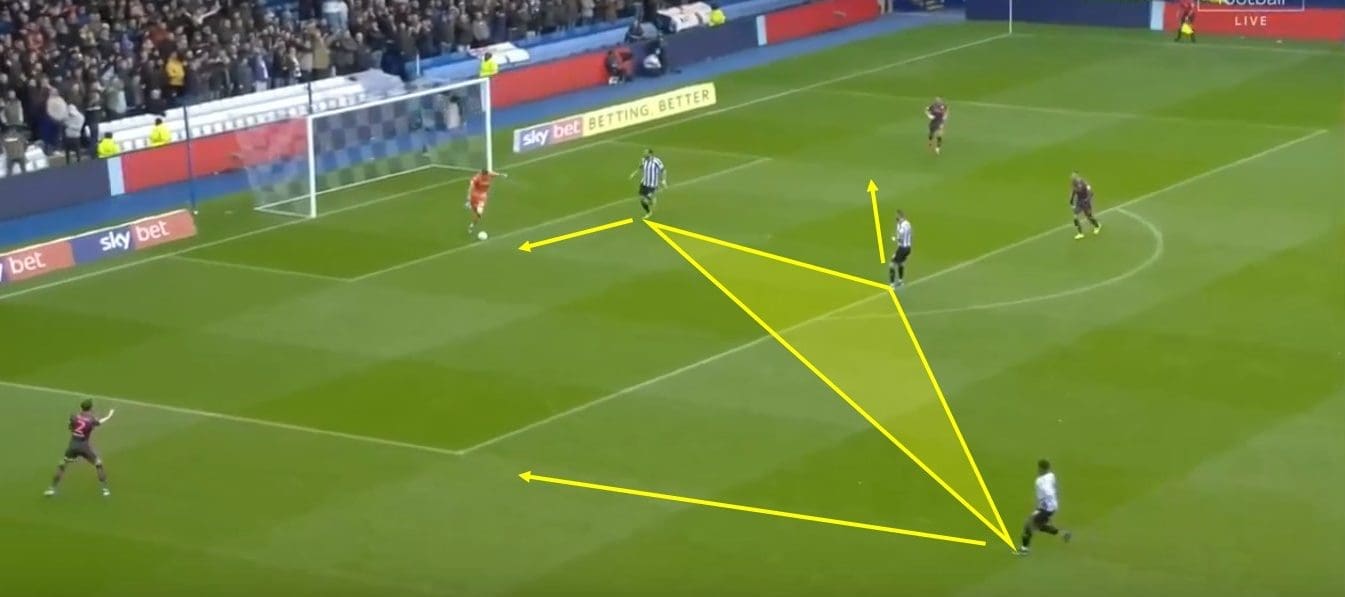
Here, inside the first minute of the game, the Owls are aggressively pressing Bielsa’s side. Nuhiu has initiated the press and as the ball is to the centre-left of Monk’s attack the two forward players are supported by the left midfielder – Kadeem Harris. As can be seen, the three pressers form a triangle-like shape where the centre point presses the man in possession and the two base points press outer passing lines to force a ball played long through the centre.
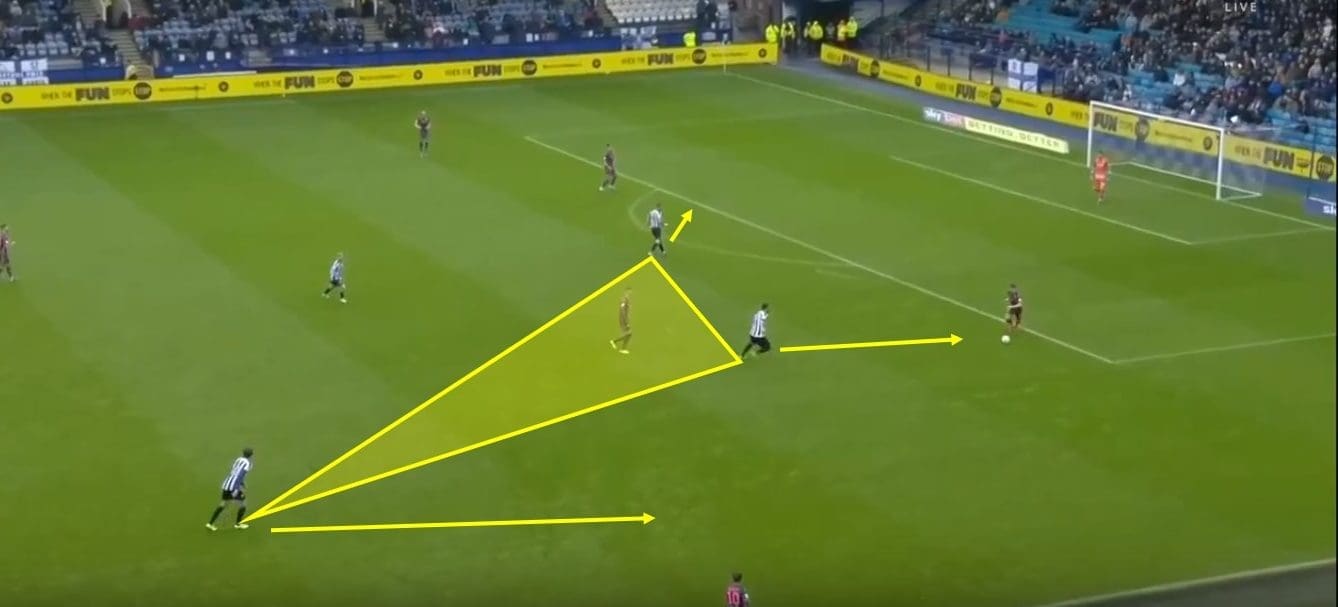
As can be seen, this continued into the second half – this time down the right-hand side of the Owls’ attack and therefore Adam Reach joins the press. Nuhiu presses as the centre point, meanwhile Fletcher and Reach press outwards to cut passing lanes and force the ball long, down the middle of the pitch. This affected Leeds’ tactic of moving the ball forwards quickly as the outside defenders of their back three did not have the time to spot the long, accurate pass. Therefore, Leeds’ tactic became weakened as this led to multiple stray passes which turned possession back over to Monk’s side.
Leeds’ counter-press
When Leeds were able to successfully move the ball up the pitch quickly, Bielsa then enforced a counter-press – otherwise known as gegenpressing – to ensure the ball stayed in Wednesday’s half. Unlike the forward ball, which was fast and long, when in the Owls’ half, Leeds’ passing became much shorter and sharper. This is a key element of the counter-press as, if possession is lost, then the counter-presser will be close enough to the ball to immediately press and win back possession within six seconds – the key principle behind gegenpressing.
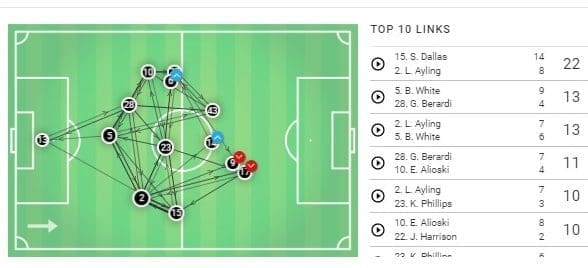
As shown by the Whites’ passing map from the match – the length of the average line of each pass is short and sharp, with midfielder Kalvin Phillips at the centre of it all. The deployment of this counter-press was to combat Monk’s aggressive press and keep the ball in Wednesday’s half of the pitch for as long as possible – therefore elevating pressure from the backline. In theory, the ball stays in the Owls’ half for a prolonged period as possession is controlled there and when lost it can be regained quickly.
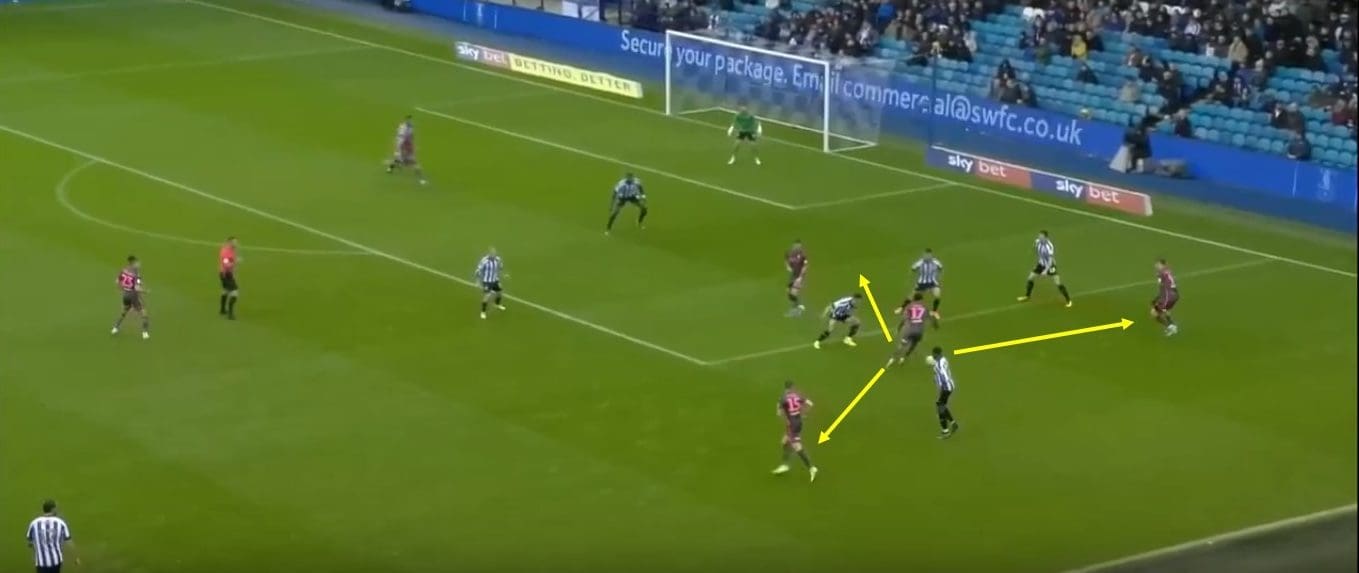
Here, it can be seen how Leeds looked to control possession while in Sheffield Wednesday’s half of the pitch. Surrounding Helder Costa are three passing options deep into the Owls’ territory. Notice, all the surrounding passing options are short, to ensure that the passing is close and sharp, which enables the Leeds attackers to be close to any Wednesday defender who would dispossess them.
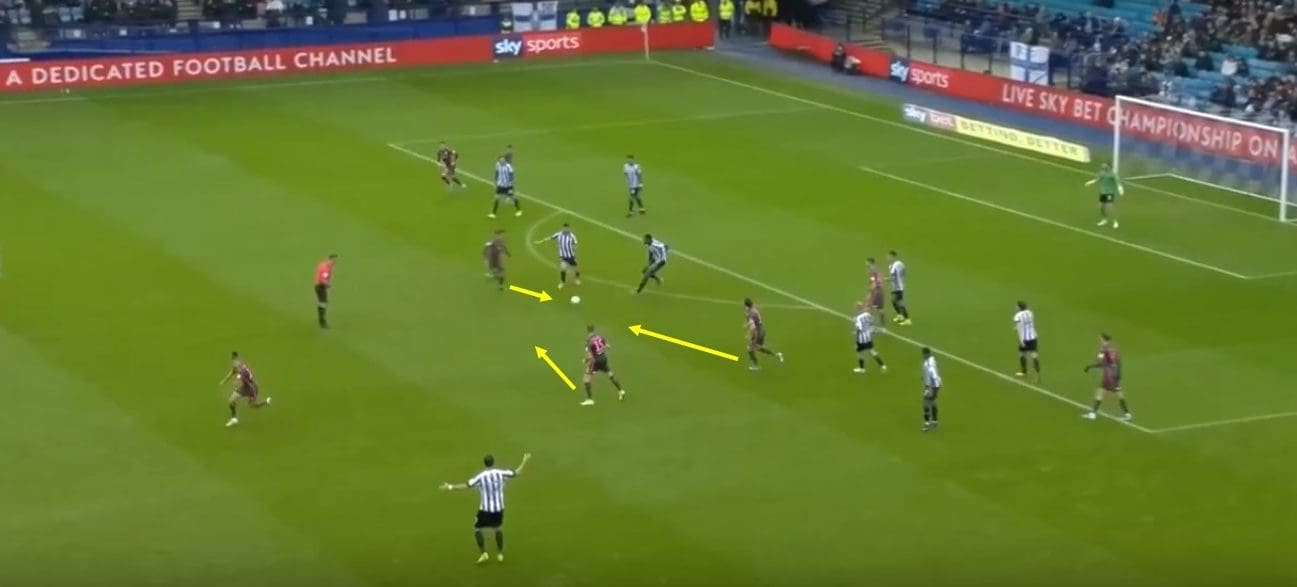
Then, a few seconds along in the same attacking sequence, Sheffield Wednesday regained possession of the ball and Leeds have put their counter-pressing tactic into work. With possession turned back over to Sheffield Wednesday, three of Bielsa’s attackers are located close to the ball and are therefore able to immediately close the ball and passing lines down. However, in this instance, Wednesday broke free of the counter-press.
Wednesday’s similar wide attack
Although the game saw both sides frustrate one another with their forms of pressing – which ultimately led to the goalless draw – Sheffield Wednesday, too, found the most success when attacking from out wide. Both sides showed a strong aversion to attacking down the centre and although both sides found quality shooting opportunities lacking – the Owls found the most success when attacking down the left-hand side of the pitch.
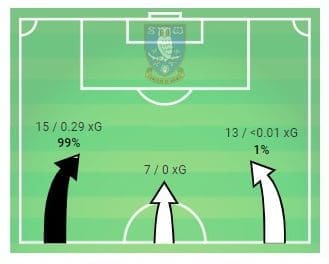
As can be seen from Monk’s side’s positional attack map above, 99% of Sheffield Wednesday’s expected goals – which itself only totalled 0.3 – came via the left side of the pitch. This was because the Owls predominantly looked to attack in the wide areas.
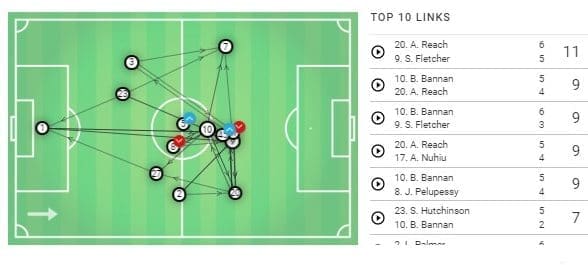
Here, on the Owls’ passing map, it can be seen how the centre of the pitch was congested for Monk’s side. However, in the wide areas in can be seen from the full-backs – Liam Palmer and Morgan Fox – their forward passes were predominantly down the line to the winger in front of them or played direct into the strikers. Similarly, the two central defenders – Sam Hutchinson and Dominic Iorfa – like the full-backs, their main passing lines go out to the wingers.
Conclusion
Gary Monk will be the happier of the two managers, with their point against high-flying Leeds another towards their hunt for an unexpected play-offs spot. Prior to the match, Bielsa probably would have been frustrated that his side was unable to claim all three points and have slipped out of the automatic promotion places, however, he will be pleased that his side was able to escape Hillsborough with a point after watching the events unfold – with both sides frustrating the other and cancelling one another out.
This tactical analysis has explained the key tactics of both Sheffield Wednesday and Leeds United in their Championship clash and used analysis to show how those tactics led to the outcome – a 0-0 draw.

If you love tactical analysis, then you’ll love the digital magazines from totalfootballanalysis.com – a guaranteed 100+ pages of pure tactical analysis covering topics from the Premier League, Serie A, La Liga, Bundesliga and many, many more. Buy your copy of the October issue for just ₤4.99 here




Comments